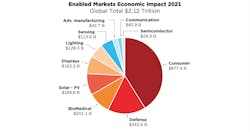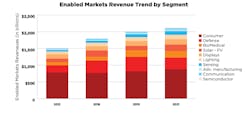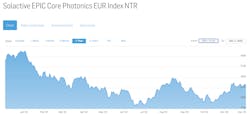A quick look at 2022 reporting and analyst summaries, it’s clear the photonics market is still demonstrating strong revenue numbers. The early returns on the Laser Focus World State of the Market report, which we will unveil at our Executive Forum event on January 30th in San Francisco, CA, echo these numbers. There is also bullish optimism for 2023 across both photonics technology manufacturers and buyers/end users.
Looking further ahead, the 5-year projections—although slightly tempered by current economic uncertainty—remain quite strong as well. While the projected number varies slightly by source, there is broad agreement that photonics revenues (and market size) will continue to grow at a steady pace through 2027 experiencing roughly 7.5% compound annual growth rate (CAGR).
Connecting the dots
Perhaps the most significant reason for the continued growth? Photonics enjoys horizontal reach. In fact, few industries have same level of expansive use as photonics. Photonics’ use across an array of industry verticals—including agriculture, automotive, communications, computing, energy, food and beverage, healthcare, manufacturing, and military/defense, among others—positions the technology as a significant enabler, especially as each market sector embraces opportunities to become smarter and more efficient (see Figs. 1 and 2).SPIE’s Fall Update of the 2022 Industry Report summarizes the importance of understanding the role of each photonics-enabled vertical: “Each of these major market segments is significant in its own right and comprises many smaller sectors. Each market moves independently of the others, but all are dependent on photonics.”
Of course, formulating an accurate assessment of where the evolving market is heading means first digging into the various industries with increasing dependency on photonics-based technology to further innovate, and then understanding the potential role.
Analyst firm McKinsey conducted its Technology Trends Outlook in August 2022 summarizing results of research and interviews into many of the horizontals touched by photonics. The McKinsey report combined the technology trends into two categories, the Silicon Age and Engineering Tomorrow.
The Silicon Age grouping includes advanced connectivity, applied AI, cloud and edge computing, immersive reality technology, industrializing machine learning, next-generation software, quantum technologies, trust architectures and digital identity, and Web3. To varying degrees, photonics is playing an often-intriguing role in each technology trend within this grouping.
Why does this matter? According to McKinsey, when combined the Silicon Age tech trends garnered $651 billion in investments in 2021. And, more importantly, these technology movements go across the range from nominal adoption to mainstream, meaning the pathway for growth remains strong.
McKinsey’s other grouping, Engineering Tomorrow, is more future-forward including trends around bioengineering, clean energy, mobility, space technologies, and sustain consumption. Again, a quick look at the breadth of global science and research initiatives demonstrates the empowering role photonics plays within each of these trends as well. Many of these technology trends could actually surface as heavy growth areas for photonics as they approach mainstream status.
Much like the Silicon Age, this grouping also sported a significant investment of $686 billion in 2021, further painting a rosy future for photonics. This is especially true as scientists and researchers continue to demonstrate the light-based technology’s many strengths and benefits compared to alternative, and more traditional technologies.
Not without challenges
The easiest way to factor in economic uncertainty is to accept that we don’t know, what we don’t know. And it is often the unknown that’s the scariest. Undoubtedly, ongoing economic issues will create bumps in the road. “The prospects for the market for photonics goods is upward in the long term, but facing some headwinds in 2023 as customers slow their spending compared to early in the pandemic; for example, in consumer products,” explains Optica Senior Industry Advisor Tom Hausken.
Of course, even with the diverse customer base enjoyed by photonics manufacturers, they are not immune to the ups and downs of the open market. After all, when measured in stock prices, photonics firms like many other technology-centric listings have not performed well in the open market. “Valuations have declined for large and small companies alike, from diversified system vendors to newly public companies in LiDAR and quantum photonics,” says Hausken. “There is a divergence between the photonics market, which is wary of a recession, and the value of publicly traded photonics companies, which were punished in the stock market last year, some pretty severely.”
The good news—time and investor confidence often corrects market numbers. A quick look at the Solactive EPIC Core Photonics Index, which tracks 71 publicly held photonics-based manufacturers, show the potential beginning of a rebound (see Fig. 3). While numbers are nowhere near January peak, they are still well above the COVID years, and at roughly a mid-point between 2022’s high and low.The unrest across the geopolitical economy is also a pressing challenge. “There is the war in Ukraine and sanctions associated with it, an ongoing trade conflict between the U.S. and China, lingering pandemic restrictions in China, and slowing demand from inflation and higher interest rates,” says Hausken. “These issues are coupled and multiplicative, even leading to political unrest. And these are not short-term threats, like the pandemic and supply chain shortages have been. There is no going back to 2019. The photonics market will continue to thrive, but there are risks for companies as they navigate changes in demand and a realigned global marketplace.”
Out-of-this-world opportunities
While McKinsey identifies the future of space technologies within the Engineering Tomorrow realm, its impact is already present in today’s world with research scientists and photonics engineers coming together to not only enable a space-influenced tomorrow, but also leverage known potential through opportunities such as satellite advances. Between 2018 and 2021, the future of space technology trend not only saw a 300% boost in investment, space also moved from essentially zero adoption to moderate adoption.
According to the McKinsey report, “The use of space technologies and remote-sensing analytics is substantial today, and analysis suggests that the space market could exceed $1 trillion. The full impact of any commercial space opportunity is now difficult to estimate, but some exciting discoveries could benefit both businesses and society as a whole. If space-based R&D allows researchers to make breakthroughs in oncology compounds, for instance, the insights could save millions of lives.”
The various new terrestrial and space telescopes in place or under construction, including the launching of the James Webb Space Telescope, undoubtedly played a role in improving the trend’s prominence. The phenomenal achievements in scientific equipment for Big Science projects never fails to impress, explains Hausken.
“We are living in the Golden Age for observing the universe, thanks to optics. Never did I imagine that in my life there would be photos from Pluto or probes landing on comets and asteroids,” he says. “LIGO (Laser Interferometer Gravitational-Wave Observatory) experiments continue to improve and correlate with other measurements. The achievements are coming so fast it’s easy to take them for granted, but we’re really living in the Golden Age of understanding the universe, and just by using our wits: some really clever uses of optics.”
Looking ahead
“There’s a saying that it takes years to become an overnight sensation, and that’s true in photonics. Consider how long it takes to become qualified and gain adoption into the medical device market, auto manufacturing, or military equipment,” says Hausken. “By the time something is adopted, or even qualified, it’s often already old news.”
Yet, it's still exciting when a technology-centric deployment takes center stage and gains public awareness. Such occurrences lend credence to the work going on behind the scenes, often for many years. Of course, photonics continues to be a well-kept secret, even from today’s otherwise tech-savvy consumer. Photonics enables most of the technologies today’s consumers appreciate. It’s possible the advanced level of science that goes into photonics makes it harder to understand. Maybe awareness is irrelevant as long as the market continues to experience continued growth.
About the Author
Peter Fretty
Market Leader, Digital Infrastructure
Peter Fretty began his role as the Market Leader, Digital Infrastructure in September 2024. He also serves as Group Editorial Director for Laser Focus World and Vision Systems Design, and previously served as Editor in Chief of Laser Focus World from October 2021 to June 2023. Prior to that, he was Technology Editor for IndustryWeek for two years.
As a highly experienced journalist, he has regularly covered advances in manufacturing, information technology, and software. He has written thousands of feature articles, cover stories, and white papers for an assortment of trade journals, business publications, and consumer magazines.




